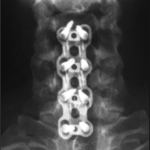
Cervical Plate
-

-

as·C·p
Cervical plate with postoperative dynamic adaptation of stabilizer
“as·C·p” (airscrew Cervical plate) with its anatomical shape and ”airscrew” blockade places itself among the most unique plates available on the market. The pre-bent design facilitates both adjustment and restoration of cervical lordosis in a transverse and longitudinal plane. ”Airscrew” blockade and oval holes in the plate ensure proper mounting of the stabilizer as well as its postoperative dynamic adaptation (avoiding over-rigidity). The plate comes in two types – symmetric and asymmetric – and many sizes (length and thickness). Cervical screws are self-cutting and available in different diameters and lengths.
Moreover, the design of the plate offers additional stabilization e.g. connection with a bone block, cage, or corpectomy prosthesis via centrally mounted screws.
-
FUNCTIONS
- Supports treatment of the cervical spine in cases of: trauma, fracture, dislocation, luxation, and others;
- Dynamic postoperative adaptation of stabilizer, countering the subsidence effect;
Compatible products:
C•Disc ๐ Cs•Disc ๐ Easy Spacer ๐ C•SPACER
-
FEATURES & BENEFITS
- Secure and simple locking mechanism;
- Anatomical shape;
- Possibility to angle the screws;
- Dynamic stabilization
- A wide range of sizes and shapes (symmetric and asymmetric) offers proper implant selection to match patient’s anatomy;
Clinical Cases
“as·C·p” plate with corpectomy prosthesis
-

-
Age: 50
Sex: W
Diagnosis: Multi-level cervical discopathy
Implanted: intervertebral disc C Disc PEEK together with the bone substitute Cerasorb M – granules, supported with cervical plate asCp L = 65mm with eight locked in plate cerival screws
clinical case link
-

-
Implanted: titanium vertebral body prosthesis supported with cervical plate asCp with cervical screws
-

-

Instruments with trials & self-cutting cervical screws
Instrumentation with trials & self-tapping neck screws

Example of optional stabilization

Dobrze dobrany implant stabilizujący jest zaprojektowany w celu zachowania funkcji biomechanicznych tylko w tych przypadkach, w których po chirurgicznym przygotowaniu następuje zrost kostny oraz przejęcie tych funkcji przez system mięśniowo-szkieletowy. Przeciwwskazania do stosowania podano w „Ogólnej Instrukcji Użytkowania Systemu Kręgosłupowego DERO”. Procedura wszczepienia stabilizatora zarezerwowana jest dla specjalistów - chirurgów kręgosłupowych - przeszkolonych w zakresie stosowania tego implantu. Główne etapy procedury są przedstawione wyłącznie w celach poglądowych. Technika zastosowana w każdym indywidualnym przypadku zawsze zależeć będzie od osądu medycznego chirurga wykonującego zabieg w celu ustalenia jak najlepszego sposobu leczenia każdego pacjenta. Prezentowane instrumentarium powinno być stosowane zgodnie ze wskazaniami zawartymi w „Podstawowej Instrukcji Użytkowania Systemu Kręgosłupowego DERO”. Proszę zapoznać się z instrukcją obsługi zawierającą kompletną listę wskazówek, ostrzeżeń, środków ostrożności i innych informacji medycznych.














